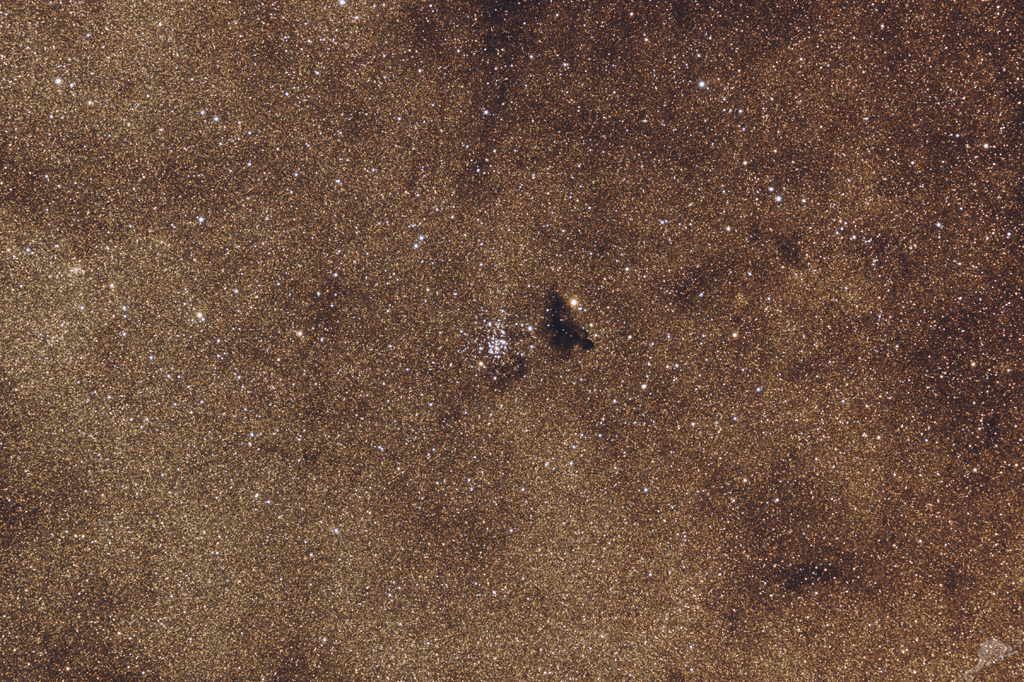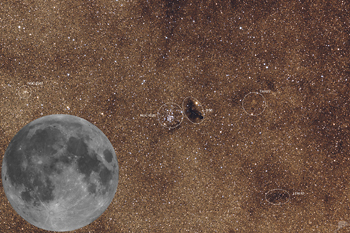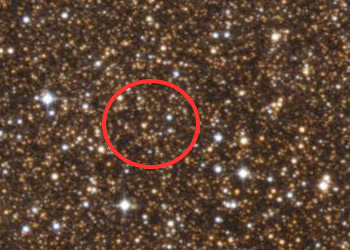 |
CHAMÄLEON + ONJALA OBSERVATORY DeepSky | SITEMAP HOME CHAMÄLEON |
|
 |
|||
| « back to overview Cluster | Load
higher resolution (1800 x 1200 Pixel 3500 x 2300 Pixel) |
Object description |

NGC 6520 and the Bok Globule Barnard 86 Our image shows the bright open star cluster NGC 6520 and its strange neighbor, the dark cloud Barnard 86, distantly reminiscent of the silhouette of a gecko. The cosmic pair stands against the background of millions of shining stars in the brightest part of our Milky Way. The stars of the Milky Way in this region of the sky are so densely packed that hardly any dark sky can be seen between them.
This part of the constellation Sagittarius hosts one of the most densely populated star fields in the entire sky - the great Sagittarius star cloud. The multitude of bright stars creates a dramatic contrast with black dark clouds like Barnard 86 in the center of this image, in a wide-angle view taken with our 5-inch EDFS refractor.
Barnard 86, a so-called Bok globule, was described by its discoverer Edward Emerson Barnard as a "drop of ink on a bright stellar background." Barnard was an American astronomer who discovered and photographed a large number of comets, dark clouds, and a moon of Jupiter, among numerous other contributions to science. An exceptionally gifted visual observer and astrophotographer, Barnard was the first to make long exposures to study dark clouds. Barnard included the object in his 1905 catalog of dark nebulae.
Barnard 86 lies in front of the star field as seen from Earth. The small dust grains that make up the cold and dense dark cloud absorb the light from the stars behind it, making the cloud opaque. Presumably we see here the remnants of the molecular cloud whose collapse created the nearby star cluster NGC 6520. The few stars that appear to be in the middle of Barnard 86 in the image are actually in the foreground, between us and the dark cloud.
As a young open cluster NGC 6520 contains many hot stars. Their blue-white glow reveals their young age. Usually open clusters consist of a few thousand stars that formed at the same time and are therefore of the same age. The clusters themselves usually stay together for a comparatively short time - a few hundred million years - before slowly drifting apart. The age of the stars in NGC 6520 is estimated to be "only" 150 million years. It is assigned to class I 2 m according to Trumpler. Together with Barnard 86 the star cluster is located in a distance of nearly 2000 light-years to our solar system. NGC 6520 was discovered by Friedrich Wilhelm Herschel on May 24, 1784.
 |
In
addition, our wide field view shows NGC 6540, a
globular cluster only 0.8 arc minutes in size. Long classified as an open
cluster, NGC 6540 is now classified as a globular cluster of concentration
class XI according to Shapley. The cluster lies at a distance of about 17,000
light-years from the solar system and was discovered by Wilhelm Herschel on May
4, 1784. West of Barnard 86 lies the globular cluster Djorg 2 (ESO 456-38) about which no further information can be found. We also have a higher resolution image of NGC 6520 and Barnard 86, taken with the PlaneWave Astrograph, which we show here. « Hier the thumbnail to load a large annoted image and a size comparison to the full moon. |
| A little curiosity The animated image section shows a field directly east of NGC 6520. Both images are adjusted in imaging scale, one image is from 07/24/2017 and was taken with the PlaneWave Astrograph. The second image was exposed to the Astro Physics EDF-S refractor almost exactly 2 years later - on 08/30/2019. What is it ? Had we discovered a previously unknown near-sun fixed star with large proper motion ? Unfortunately not, according to databases it is 2 variable stars of Mira type. If you look at the animation of the complete image field, it is amazing how many variable stars are "blinking" there. There is always something new to discover. |
 |
 |
 |
 |
 |
 |
 |
 |
| Sun | Moon | Solar System | DeepSky | Widefield | Miscellaneous | Spec. Projects |